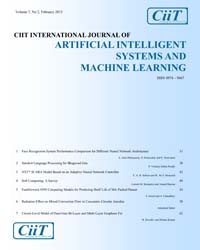Trigram Based Word Sense Disambiguation Using Neural Network
Subscribe/Renew Journal
This paper presents a method to solve word sense ambiguity using neural network. Most of the previous word sense disambiguation approaches were based on neural networks, having limitations due to their huge feature set size. Here, trigram method is adopted in three ways:pre-trigram (wr1r2-ambiguous word (w) and immediate two right words (r1r2)), in-trigram (l1wr1-immediate left word (l1), ambiguous word (w) and immediate right word (r1)) and post-trigram (l2l1w-immediate left two words (l2l1) and ambiguous word (w)). Three trigram features are treated as input for five different neural networks, defined with one hidden layer with hidden neurons ranging from two to twenty. The input model is extracted from Brown corpus. In this, the performances of the networks are compared using mean squared error (mse) values. Among all networks, in-trigram based pattern recognition neural network gives 78.15% of accuracy.
Keywords
In-Trigram, Neural Network, Post-Trigram, Pre-Trigram and Word Sense Disambiguation.
User
Subscription
Login to verify subscription
Font Size
Information

Abstract Views: 373

PDF Views: 4



